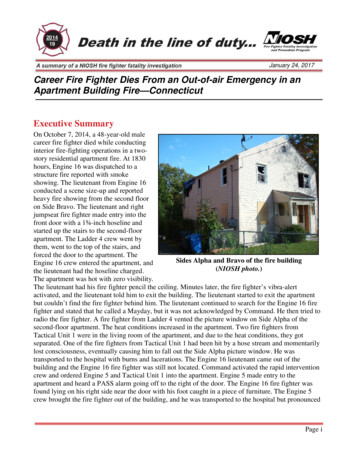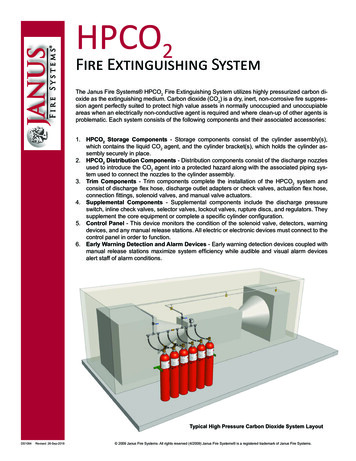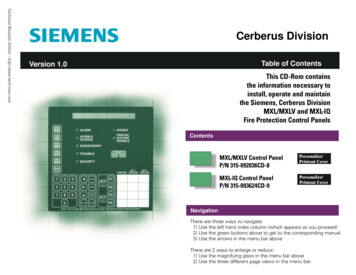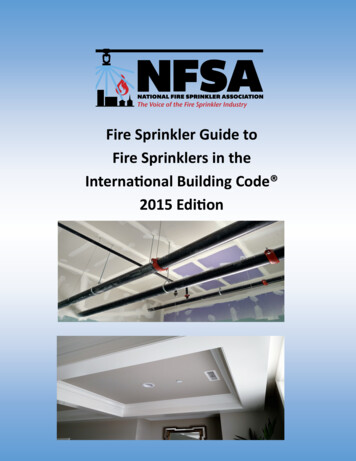
Transcription
201419January 24, 2017Career Fire Fighter Dies From an Out-of-air Emergency in anApartment Building Fire—ConnecticutExecutive SummaryOn October 7, 2014, a 48-year-old malecareer fire fighter died while conductinginterior fire-fighting operations in a twostory residential apartment fire. At 1830hours, Engine 16 was dispatched to astructure fire reported with smokeshowing. The lieutenant from Engine 16conducted a scene size-up and reportedheavy fire showing from the second flooron Side Bravo. The lieutenant and rightjumpseat fire fighter made entry into thefront door with a 1¾-inch hoseline andstarted up the stairs to the second-floorapartment. The Ladder 4 crew went bythem, went to the top of the stairs, andforced the door to the apartment. TheSides Alpha and Bravo of the fire buildingEngine 16 crew entered the apartment, and(NIOSH photo.)the lieutenant had the hoseline charged.The apartment was hot with zero visibility.The lieutenant had his fire fighter pencil the ceiling. Minutes later, the fire fighter’s vibra-alertactivated, and the lieutenant told him to exit the building. The lieutenant started to exit the apartmentbut couldn’t find the fire fighter behind him. The lieutenant continued to search for the Engine 16 firefighter and stated that he called a Mayday, but it was not acknowledged by Command. He then tried toradio the fire fighter. A fire fighter from Ladder 4 vented the picture window on Side Alpha of thesecond-floor apartment. The heat conditions increased in the apartment. Two fire fighters fromTactical Unit 1 were in the living room of the apartment, and due to the heat conditions, they gotseparated. One of the fire fighters from Tactical Unit 1 had been hit by a hose stream and momentarilylost consciousness, eventually causing him to fall out the Side Alpha picture window. He wastransported to the hospital with burns and lacerations. The Engine 16 lieutenant came out of thebuilding and the Engine 16 fire fighter was still not located. Command activated the rapid interventioncrew and ordered Engine 5 and Tactical Unit 1 into the apartment. Engine 5 made entry to theapartment and heard a PASS alarm going off to the right of the door. The Engine 16 fire fighter wasfound lying on his right side near the door with his foot caught in a piece of furniture. The Engine 5crew brought the fire fighter out of the building, and he was transported to the hospital but pronouncedPage i
Report # F2014-19Career Fire Fighter Dies From an Out-of-air Emergency in anApartment Building Fire—Connecticutdead upon arrival. The Engine 16 lieutenant sustained injuries but was treated and released. TheTactical Unit 1 fire fighter who had fallen out the window remained in the hospital for 23 days.Contributing Factors Fireground tacticsCrew integrityPersonnel accountabilityAir managementMayday proceduresFireground communicationsVentilationPersonal protective equipment useLive fire trainingUnsprinklered occupancyKey Recommendations Fire departments should ensure that risk assessments are conducted prior to initial operationsand throughout the incident and that the strategy and tactics match the assessment. Fire departments should ensure that crew integrity is properly maintained by voice or radiocontact when operating in an immediately dangerous to life or health (IDLH) atmosphere. Fire departments should ensure that fire fighters and officers are properly trained in airmanagement including out-of-air emergencies. Fire departments should use a personnel accountability system that accounts for all resourcesassigned to an incident. Fire departments should ensure that incident commanders incorporate the principles ofcommand safety into the incident management system. Fire departments should ensure fire fighters are properly trained in Mayday procedures. Fire departments should provide the incident commander with a Mayday tactical checklist foruse in the event of a Mayday.The National Institute for Occupational Safety and Health (NIOSH), an institute within the Centers for Disease Control andPrevention (CDC), is the federal agency responsible for conducting research and making recommendations for the prevention ofwork-related injury and illness. In 1998, Congress appropriated funds to NIOSH to conduct a fire fighter initiative that resulted in theNIOSH Fire Fighter Fatality Investigation and Prevention Program, which examines line-of-duty deaths or on-duty deaths of firefighters to assist fire departments, fire fighters, the fire service and others to prevent similar fire fighter deaths in the future. Theagency does not enforce compliance with state or federal occupational safety and health standards and does not determine fault orassign blame. Participation of fire departments and individuals in NIOSH investigations is voluntary. Under its program, NIOSHinvestigators interview persons with knowledge of the incident who agree to be interviewed and review available records to developa description of the conditions and circumstances leading to the death(s). Interviewees are not asked to sign sworn statements andinterviews are not recorded. The agency's reports do not name the victim, the fire department, or those interviewed. The NIOSHreport's summary of the conditions and circumstances surrounding the fatality is intended to provide context to the agency'srecommendations and is not intended to be definitive for purposes of determining any claim or benefit.For further information, visit the program website at www.cdc.gov/niosh/fire or call toll free 1-800-CDC-INFO (1-800-232-4636).Page ii
201419January 24, 2017Career Fire Fighter Dies From an Out-of-air Emergency in anApartment Building Fire—ConnecticutIntroductionOn October 7, 2014, a 48-year-old male career fire fighter died while conducting interior operations ina two-story residential apartment. On October 9, 2014, the U.S. Fire Administration notified theNational Institute for Occupational Safety and Health (NIOSH) of this incident. On October 14–24,2014, a general engineer, an occupational safety and health specialist, and an investigator from theNIOSH Fire Fighter Fatality Investigation and Prevention Program (FFFIPP) traveled to Connecticutto investigate this incident. The NIOSH FFFIPP investigators met with members of the career firedepartment, International Association of Fire Fighters local union, Connecticut State Police,Connecticut Division of Occupational Safety and Health, and the city dispatch center. NIOSH FFFIPPinvestigators interviewed the incident commander and fire fighters who were on-scene at the time ofthe incident. The NIOSH FFFIPP investigators visited the incident site, took photographs, andcollected and reviewed training records, standard operating procedures, and medical records. The selfcontained breathing apparatus (SCBA) from the Engine 16 fire fighter (Engine 16B) and Tactical Unit1 fire fighter were evaluated by the NIOSH National Personal Protective Technology Laboratory.Fire DepartmentThe career fire department involved in this incident serves a city with a population of over 125,000 andhas a total area of 17.38 square miles. The fire department employs 395 personnel and averages about23,053 response calls annually. The fire department is subdivided into two main fields of operation:Emergency Services and Support Services. The Support Services is comprised of the FireAdministration staff and the Employee Assistance Program. Under command of the Support ServicesDivision are the Fire Marshal’s Office, Equipment Maintenance Division, Fire Alarm CommunicationsTechnology Division, Fire Training Division, and Special Events Unit.The Emergency Services Division is comprised of 12 fire stations, which are divided into 2 districts.Each district is commanded by a district chief. Each shift is commanded by a deputy fire chief. Theapparatus fleet consists of 11 engines, 5 ladders, 1 tactical unit (Heavy Rescue), and numerous special,support, and reserve units. All front-line apparatus are staffed with a minimum crew of three firefighters and an officer (captain or lieutenant). The fire department uses the following designations forriding assignments on the fire apparatus: Officer is “A,” right jumpseat is “B,” left jumpseat is “C,”and the engineer operator is “D.”Emergency medical service is provided by two separate ambulance companies. Each ambulancecompany is assigned a response area within one of the two districts in the city.Page 1
Report # F2014-19Career Fire Fighter Dies From an Out-of-air Emergency in anApartment Building Fire—ConnecticutTraining and ExperienceThe fire department involved in this incident requires potential candidates for employment as a firefighter to have a high school diploma or GED and a valid state driver’s license and to successfully passa background check and an entry-level civil service test.Once selected as a candidate, the initial step is to attend the 16-week recruit training program at thedepartment’s fire academy. The curriculum covers all of the National Fire Protection Association's(NFPA) qualifications for NFPA 1001 Standard on Fire Fighter Professional Qualifications. Thisincludes Fire Fighter I, Fire Fighter II, Hazardous Materials Awareness, Hazardous MaterialsOperations, and emergency medical care [NFPA 2013a].Upon completion of recruit school, the fire chief assigns the recruit to a station where they become aprobationary fire fighter for 1 year. Upon completion of probation, the fire fighter trainee becomes afire fighter. After 5 years of experience, a fire fighter can take the lieutenant test. A fire fighter can testfor an apparatus operator after 3 years in-grade. After being promoted to the lieutenant rank, the officercan test for the next rank of captain, district chief, and deputy chief after 3 years in-grade.The department’s training academy has a full complement of staff. However, due to budgetaryconstraints, the staff is not authorized overtime and the facilities are in need of repairs. The trainingacademy has a burn building, but it hasn’t been used for years and is currently condemned. Also, thefire academy adjoins the police academy with an operational firing range. No fire fighter training cantake place outside when the firing range is in use due to rounds ricocheting onto the training grounds.Table 1. Summarizes the documented training of the Engine 16 right jumpseat fire fighter(Engine 16B), the Engine 16 lieutenant (Engine 16A), and the incident commander (DistrictChief 2).Fire FighterTraining CoursesYearsExperienceFire Fighter B(Engine 16B)Basic Fire Fighting (Fire Fighter I, Fire Fighter II),Introduction to the Incident Command System (IS100), ICS for Single Resources and Initial ActionIncidents (IS-200), Rail Safety for EmergencyResponders, various fire-fighting procedures, andvarious other administrative and technical courses.6Lieutenant(Engine 16A)Basic Fire Fighting (Fire Fighter I, Fire Fighter II),Pump Operator, Introduction to the IncidentCommand System (IS-100), ICS for SingleResources and Initial Action Incidents (IS-200),National Incident Management System (NIMS) An19Page 2
Report # F2014-19Career Fire Fighter Dies From an Out-of-air Emergency in anApartment Building Fire—ConnecticutIntroduction (IS-700.a), and various otheradministrative and technical courses.District Chief 2Basic Fire Fighting (Fire Fighter I, Fire Fighter II),(Incident Commander) Introduction to the Incident Command System (IS100), ICS for Single Resources and Initial ActionIncidents (IS-200), National Incident ManagementSystem (NIMS) An Introduction (IS-700.a), andvarious other administrative and technical courses.26Note: All fire fighters must complete training equivalent to the NFPA 1001 Standard for Fire FighterProfessional Qualifications, Fire Fighter I and Fire Fighter II [NFPA 2013a].StructureThe two-story apartment building was built in 1953 and constructed of a wood frame on a pouredconcrete basement foundation (see Photos 1–4). The two-story structure consisted of 2,016 square feetof total living space between the two apartments. Each floor consisted of five rooms that included twobedrooms, a living room, a kitchen, and a bathroom. The exterior was covered with vinyl siding, andthe pitched roof was covered with asphalt shingles. The structure had a front entrance with two doors:the one on the left opened to an interior stairway to the second floor, and the one on the right to thefirst-floor apartment. At the top of the stairway was a door with a dead bolt and a second door to theright with a normal entry knob. There was a rear entrance to both floors via a covered porch with stairsto the second floor. The structure had an unoccupied third apartment in the finished basement with anexterior entrance in the rear (Side Charlie) of the structure. The building’s utilities were electric andnatural gas heating.Page 3
Report # F2014-19Career Fire Fighter Dies From an Out-of-air Emergency in anApartment Building Fire—ConnecticutPhoto 1. Side Alpha—street view of the duplex. Engine 16 and Ladder 4 made entryinto the building through the left doorway.(NIOSH photo.)Page 4
Report # F2014-19Career Fire Fighter Dies From an Out-of-air Emergency in anApartment Building Fire—ConnecticutPhoto 2. Side Bravo—street view of the duplex. Origin of fire near theBravo/Charlie corner on the second floor.(NIOSH photo.)Page 5
Report # F2014-19Career Fire Fighter Dies From an Out-of-air Emergency in anApartment Building Fire—ConnecticutPhoto 3. Side Charlie of the structure. An unoccupied apartment was in thebasement. The entrance to the basement apartment is on the Bravo/Charliecorner.(NIOSH photo.)Page 6
Report # F2014-19Career Fire Fighter Dies From an Out-of-air Emergency in anApartment Building Fire—ConnecticutPhoto 4. Side Delta of the structure. A rear entrance leads to the first- and second-floorapartments on the Delta/Charlie corner(NIOSH photo.)Equipment and PersonnelOn October 7, 2014, the dispatch center transmitted an alarm for a structure fire with smoke showing.The initial units dispatched included Engine 16, Engine 14, Engine 7, Ladder 4, Ladder 3, TacticalUnit 1, and District 2. Upon arrival, Engine 16 advised this was a working fire. This upgraded thealarm to a working-fire dispatch, which added another district chief and two engines. Table 2 identifiesthe apparatus and staff dispatched on the first-alarm assignment and the working-fire assignment,along with their approximate dispatch times and on-scene arrival times rounded to the nearest minute.Page 7
Report # F2014-19Career Fire Fighter Dies From an Out-of-air Emergency in anApartment Building Fire—ConnecticutTable 2. First-alarm and working fire equipment and personnel dispatched.Resource DesignationStaffingDispatched(rounded to minute)1830 hrsOn-scene(rounded to minute)1832 hrsEngine 16lieutenant, engineoperator, and 2 firefightersLadder 4lieutenant, engineoperator, and 2 firefighters1830 hrs1834 hrsEngine 14lieutenant, engineoperator, and 2 firefighters1830 hrs1834 hrsDistrict Chief 2(Incident Commander)district chief andchief’s aide1830 hrs1834 hrsLadder 3lieutenant, engineoperator, and 2 firefighters1830 hrs1836 hrsTactical Unit 1lieutenant, and 4 firefighters1830 hrs1837 hrsEngine 7lieutenant, engineoperator, and 2 firefighters1830 hrs1838 hrsEngine 5lieutenant, engineoperator, and 2 firefighters1832 hrs1840 hrsDistrict Chief 1district chief andchief’s aide1835 hrs1840 hrsEngine 2lieutenant, engineoperator, and 2 firefighters1835 hrs1840 hrsTimelineAn approximate timeline summarizing the significant events of the incident is listed below. The timesare approximate and were obtained by studying available dispatch records, photos, run sheets, witnessstatements, and fire department records. The times are rounded to the nearest minute. The timeline isnot intended, nor should it be used, as a formal record of events.Page 8
Report # F2014-19Career Fire Fighter Dies From an Out-of-air Emergency in anApartment Building Fire—Connecticut 1830 HoursEngine 16, Engine 14, Engine 7, Tactical Unit 1, Ladder 4, Ladder 3, and District 2 aredispatched to a structure fire with smoke showing. 1832 HoursEngine 5 is dispatched as the rapid intervention team (RIT); Engine 16 arrives on-scene andassumes command. 1833 HoursDistrict Chief 2 is en route and on the air; Engine 16 reports a 2½-story wood frame with heavysmoke showing. Engine 16 advises this would be a “working fire.” 1834 HoursDistrict Chief 2 advises the dispatch center that Engine 16 said this would be a working fire;Ladder 4, Engine 14, and District Chief 2 arrive on-scene. 1835 HoursDistrict Chief 1 and Engine 2 are dispatched to a working fire. 1836 HoursLadder 3 arrives on-scene; Engine 14 at hydrant. 1837 HoursTactical Unit 1 arrives on-scene; Engine 14 brings hoseline around to Side Charlie. 1838 HoursEngine 7 arrives on-scene. Engine 16 enters the stairwell to second floor with Ladder 4. 1839 HoursEngine 5, District Chief 1, and Engine 2 arrive on-scene; District Chief 1 assigned as SafetyOfficer; Engine 14 and Ladder 3 make entry on second floor rear with a charged 1¾-inchhoseline. 1840 HoursEngine 16 makes entry to second-floor apartment with a charged 1¾-inch hoseline. 1842 HoursEngine 14 puts water on fire from exterior of Side Charlie. 1844 HoursCommand requests reports from Engine 16 and Engine 14. Replies are inaudible.Page 9
Report # F2014-19Career Fire Fighter Dies From an Out-of-air Emergency in anApartment Building Fire—Connecticut 1845 HoursEngine 16 calls a Mayday but is not acknowledged by Command or any other personnel. 1846 HoursCommand orders evacuation of the structure and requests medic unit. 1847 HoursCommand requests a status of injuries and a PAR. Ladder 3 requests tone for all companies outof the building. 1849 HoursEngine 16A tries to radio Engine 16B; Engine 14 has PAR. 1850 HoursEngine 16A tries to radio Engine 16B; Engine 7 charges their hoseline on Side Bravo. 1851 HoursEngine 16A tries to radio Engine 16B. 1852 HoursCommand requests second alarm. 1853 HoursCommand orders Ladder 4 to open up the roof. Command contacts Engine 16A, who ischanging his SCBA cylinder, and asks where Engine 16B is located. Engine 16A states they areon the second floor in the room on the right; Command activates the RIT (Engine 5 andTactical Unit 1). 1854 HoursEngine 5 hears PASS device going off to the right and locates Engine 16B. 1855 HoursRIT crew moves Engine 16B down the stairway. 1857 HoursEngine 7 knocks down the fire in the Bravo/Charlie corner, second-floor bedroom. 1900 HoursMedic unit en route to hospital. 1909 HoursEngine 2 and Ladder 5 crews complete the extinguishment of the fire on the second floor.Page 10
Report # F2014-19Career Fire Fighter Dies From an Out-of-air Emergency in anApartment Building Fire—ConnecticutPersonal Protective EquipmentThe Engine 16B fire fighter was wearing a work station uniform, turnout coat and pants, gloves, boots,helmet, self-contained breathing apparatus (SCBA) with an integrated personal alert safety system(PASS), and a portable radio.Engine 16B’s and Tactical Unit 1’s SCBAs were evaluated by the NIOSH National Personal ProtectiveTechnology Laboratory and a summary report is enclosed as Appendix I. The evaluation showed thatEngine 16B’s SCBA failed the Remaining Service Life Indicator Test, in which the secondary bellfailed to operate within the parameters but passed all other NIOSH tests. Tactical Unit 1’s SCBA didnot meet the requirements for the 30-minute minimum duration test but passed all other NIOSH tests.The full report is available upon request.Weather ConditionsAccording to data from the Weather Underground, the sky conditions were clear with 10-milevisibility. The temperature was 92 degrees F. Dew point was 73 degrees F. Relative humidity was78%. Wind speed was 8.1 miles per hour and wind direction was south. Barometric pressure was 29.99[NOAA 2015].InvestigationOn October 7, 2014, a 48-year-old male career fire fighter died while conducting interior operations ina two-story residential apartment. At 1830 hours, Engine 16, Engine 14, Engine 7, Ladder 4, Ladder 3,Tactical Unit 1, and District 2 were dispatched to a structure fire with smoke showing. Uponconfirmation of a working fire, Engine 5, Engine 2 and District 1 were added to the alarm. The Engine16 lieutenant (Engine 16A) observed heavy smoke in the air from a block and half away. Engine 16laid into the fire from a hydrant approximately a block and half away from the fire building. A firefighter (left jump seat) from Engine 16 (Engine 16C) was the hydrant man and made the connectionand waited for the order to charge the supply line. Engine 16 pulled past the building to allow space forLadder 4. A fire fighter from Engine 16 (Engine 16B) pulled a 1¾-inch hoseline while Engine 16Aradioed heavy fire was showing on Side Bravo. At approximately 1834 hours, Ladder 4, Engine 14,and the chief from District 2 (District Chief 2) arrived on-scene. District Chief 2 assumed commandwhile Engine 14 laid in from a hydrant two blocks away. Ladder 4 forced the first-floor door to thesecond-floor apartment. Engine 16A and Engine 16B made entry into the stairwell and started up thestairs to the second-floor apartment. The crew from Ladder 4 went by Engine 16 and went to the top ofthe stairs. In near zero visibility, Ladder 4 felt a dead bolt on the door at the top of the stairs in front ofthem but no door knob, then felt a locked door knob on a door to their right, which Ladder 4 forcedopen. The Engine 14 crew had a back-up 1¾-inch line out front and were redirected by Command togo to the rear (Side Charlie) and make entry up the stairs. The crew from Engine 7 replaced Engine 14in the front to back up Engine 16. At approximately 1839 hours, Engine 14, with the help of Ladder 3,made entry on the second-floor rear with a charged 1¾-inch hoseline. Engine 5, District Chief 1, andEngine 2 arrived on-scene. Command assigned District Chief 1 as the Safety Officer, Engine 5 as RIT,and Engine 2 as rehab.Page 11
Report # F2014-19Career Fire Fighter Dies From an Out-of-air Emergency in anApartment Building Fire—ConnecticutUpon entry, Engine 16A reported the apartment was hot with zero visibility. At approximately 1840hours, Engine 16A had the line charged and had Engine 16B pencil the ceiling. Ladder 4 also reportedthe second-floor apartment was hot with zero visibility and began a right-hand search on their knees.Minutes later, Ladder 3 reported to Command that Engine 14 was hitting the fire from Side Charlie.Engine 16C had gone to the rear with Engine 14. About this time, the Engine 16B’s vibra-alertsounded and the lieutenant told him to exit. Tactical Unit 1 had made entry from the rear stairwell tothe second-floor apartment. They passed Ladder 3 and Engine 14 in the kitchen area. Tactical Unit1began pulling ceiling in the living room looking for fire.A fire fighter from Ladder 4 vented the picture window on Side Alpha of the second-floor apartment.The Ladder 4 lieutenant reported a rapid increase in heat in the apartment and ordered his crew out.Engine 16A headed for the door but lost contact with Engine 16B. Engine 16A found the hoseline withthe nozzle shut off near the door. Due to the extreme heat in the room, Engine 16A opened up thenozzle to cool down the room. Three members of Tactical Unit 1’s crew who were in the living roomnear the kitchen pulling ceiling, were struck by a hose stream coming from somewhere near SideAlpha of the living room. The crew became separated. One member of Tactical Unit 1 exited out therear stairwell through the kitchen. The other two fire fighters reported being hit in the face and chestand momentarily became disorientated. One member made it to the kitchen and located the lieutenantand a fire fighter who had also been hit by a hose stream. Engine 14’s hoseline had become loose butthey were able to secure it. All the fire fighters who were hit with the hose stream had their helmetsknocked off and SCBA facepieces dislodged. An Engine 14 fire fighter became disorientated andconfused having been hit twice with the hose stream. He needed assistance exiting the structure.The third fire fighter from Tactical Unit 1 had taken a direct hit to the face; he lost his helmet, hisfacepiece was dislodged, and he was knocked down by the hose stream. He stated he was unconsciousfor a brief period of time. He was unable to locate his helmet and facepiece and stated that his head andeyes were burning from the extreme heat in the apartment. He used his wet gloves to try to cool hishead and face. He was unable to locate any fire fighters or use his radio. He ended up at the Side Alphapicture window that Ladder 4 had previously vented. Fire fighters on the ground noticed him at thewindow and tried to communicate to him that they were getting a ground ladder. At approximately1846 hours, he lost consciousness and tumbled out the window to the ground. Command orderedeveryone out of the structure and requested a medical unit. The EMS crew arrived and he wastransported to the hospital. Note: The Tactical Unit 1 member sustained burns to his head, ears, neck,shoulder, and wrist; he was hospitalized in a burn unit for approximately 23 days.Engine 16A continued the search for Engine 16B until his vibra-alert activated. Engine 16A stated thathe called a Mayday, but it was not acknowledged; he also tried to radio Engine 16B. Engine 16Acrawled out of the apartment with no air left in his cylinder and exited the structure. Upon his exit,Engine 16A had noticed that a fire fighter was being attended to on the ground on Side Alpha. Onseveral occasions, Command tried to contact Engine 16A with no response. For several minutes, thelieutenant tried to locate Engine 16B with no success. At approximately 1856 hours, the lieutenantPage 12
Report # F2014-19Career Fire Fighter Dies From an Out-of-air Emergency in anApartment Building Fire—Connecticutnotified Command that he couldn’t find his fire fighter. Immediately, Command tried to radio Engine16B but got no response.At approximately 1858 hours, Command activated the rapid intervention crew, which sent Engine 5and Tactical Unit 1 into the apartment. Engine 5 made entry into the second-floor apartment. TheEngine 5 officer looked at his thermal imager and the screen was white, but he heard a PASS alarmgoing off to the right of the door. Engine 16B was found lying on his right side near the door. The crewgrabbed Engine 16B but he appeared to be caught on something. Engine 16B’s lower right leg and footwere entangled in a piece of wrought iron furniture (see Diagram 1). The RIC crew untangled him andcarried him down the stairs to EMS waiting outside. Engine 16B’s SCBA was intact and properlydonned on his face but the air cylinder was empty. At approximately 1900 hours, EMS started CPR onEngine 16B. Engine 16B was transported to the hospital but pronounced dead upon arrival. Engine16B did not appear to have sustained any burns or other life-threatening injuries.At approximately 1909 hours, Engine 2 and Ladder 5 crews knocked down the fire in the bedroom onthe Bravo/Charlie corner.Page 13
Report # F2014-19Career Fire Fighter Dies From an Out-of-air Emergency in anApartment Building Fire—ConnecticutApproximatelocation of whereE16B Fire Fighterwas found.Diagram. Floor plan of second floor, path of attack crews, and locationof fire fighters found.(Diagram courtesy of the fire department.)Page 14
Report # F2014-19Career Fire Fighter Dies From an Out-of-air Emergency in anApartment Building Fire—ConnecticutFire BehaviorThe origin and cause of the fire is still under investigation by the Connecticut State Police’s Fire andExplosion Investigation Unit. By all accounts, the fire originated on the second floor, in the bedroomon the Bravo/Charlie corner of the fire structure.Indicators of significant fire behavior Smoke on Bravo/Charlie corner upon arrival Fire showing on Side Bravo Heat and heavy, black smoke throughout the second floor Fire self-vents out two windows on Bravo/Charlie corner and extended up the exterior wall Heavy fire at Bravo/Charlie corner on second floor and attic No vertical ventilation at this time Heat and heavy, black smoke continue to fill second floor Side Alpha window removed, creating a flow path for the fire Fire knocked down approximately 41 minutes after arrivalContributing FactorsOccupational injuries and fatalities are often the result of one or more contributing factors or keyevents in a larger sequence of events that ultimately result in the injury or fatality. NIOSHinvestigators identified the following items as key contributing factors in this incident that led to thefatalities: Fireground tactics Crew integrity Personnel accountability Air management Mayday procedures Fireground communications Ventilation Personal protective equipment use Live fire training Unsprinklered occupancyCause of DeathAccording to the chief medical examiner’s report, the cause of death of the fire fighter was lack ofbreathing gas. The report listed cardiac hypertrophy as a contributing factor.Page 15
Report # F2014-19Career Fire Fighter Dies From an Out-of-air Emergency in anApartment Building Fire—ConnecticutRecommendationsRecommendation #1: Fire departments should ensure that risk assessments are conducted prior toinitial operations and throughout the incident and that the strategy and tactics match theassessment.Discussion: Occupancies define the space inside the class of building. Construction types/classes ofconstruction define how the building is constructed with either combustible or noncombustiblematerials. Occupancies exist inside the constructed building. Standard operation procedures (SOPs)must consider numerous factors that affect fire-fighting operations. This will ensure essentialstrategic-, tactical-, and task-level functions are performed by the inci
interior fire-fighting operations in a two-story residential apartment fire. At 1830 hours, Engine 16 was dispatched to a . Tactical Unit 1 were in the living room of the apartment, and due to the h











